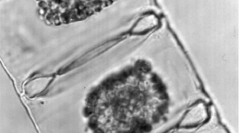

 Cryptogamie, Algologie
34 (3) - Pages 245-254
Cryptogamie, Algologie
34 (3) - Pages 245-254In this paper, we show morphological features of two marine planktonic diatoms that are phylogenetically related, as suggested by molecular studies: Bellerochea malleus and Helicotheca tamesis. In order to study Bellerochea malleus specimens of the species were isolated from samples collected from marginal coral reefs located in the southern portion of Puerto Rico and cultured in the laboratory. Specimens of the species Helicotheca tamesis were isolated from net phytoplankton samples collected from the tropical Mexican Pacific and also cultured in the laboratory. The two species were examined by means of light and scanning electron microscopy. The morphology of Bellerochea malleus agrees well with previous reports: cells arranged in relatively long chains, united by the horn-shaped apical elevations, elliptical valves (not triangular) with depressed valve face bearing an eccentric annulus, from which numerous costae radiate, formation of costate ocelli, and one eccentric or marginal protruded and tubular rimoportula per valve. Helicotheca tamesis also shows the typical morphological features of this species: cells are solitary or form long and distinctly twisted chains, with no apparent apertures between sibling valves, valves are linear to elliptical, weakly silicified and flat. Furthermore, we found one conspicuous and protruded rimoportula per valve, located eccentrically or marginally (not central as previously described), consisting of an elliptic tubular structure. The cingulum is composed of numerous half-bands and segmented copulae. This study compares the morphology of these two species, with a special emphasis on the structure of the rimoportulae.